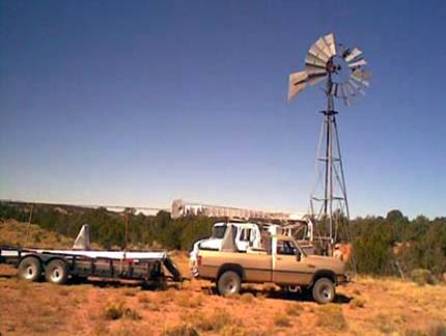Branch of Water Resources
The BIA water program is executed under the direction of two Deputy Bureau Directors of the BIA: 1) the Deputy Bureau Director – Trust Services oversees the Central Office water program functions; and 2) the Deputy Bureau Director – Field Operations oversees the Regional Office and local Agency water program functions.
The Central Office water program functions are carried out under the direction of the Chief, Division of Natural Resources. The Branch of Water Resources within the Division consists of two professional staff: Hydrologist/Engineer and Water Rights Specialist. The Central Office Staff provides policy, oversight, and technical support functions. The staff also provides input into the annual budget preparation and coordinates the data collection for the various performance measure programs currently in place. One of the primary functions of the water program staff is the implementation of the established process for distributing annually appropriated water program funds to the regions and the tribes.
The Regional Office and local Agency water program functions are carried out by the professional staff primarily at the Regional Offices. Few of the Agencies have water program staff other than as assigned collateral duties. The regional water staff provides technical assistance to tribes and coordinates the process of soliciting water-related funding proposals from tribes and identifying funding needs for studies required in ongoing Indian water rights litigation cases and for advancing water rights negotiations for tribes under the Region’s jurisdiction. Determining funding needs for water rights negotiations/litigation requires consultation with the DOI/Solicitor’s Office and the Department of Justice attorney assigned to the case. In addition, the regional water staffs are utilized as BIA representative members of appointed Federal Indian Water Rights Negotiation Teams. Regional staffs also often participate in various federal, state, and local water program activities in support of the United State’s trust responsibilities for protecting Indian water rights.

Figure 1 - July 8-10, 2008, National Water Programs meeting at the BIA’s Midwest Regional Office, Fort Snelling, Minnesota to review the current funding procedures. From left: Cathy Wilson (Western RO), Mary Manydeeds (Midwest RO), David Anderson (Southern Plains RO), Marilyn Bercier (Great Plains RO), Chris Reeves (Pacific RO), Kevin Bearquiver (Midwest RO), Sharon Pinto (Navajo RO), Terry Virden (Midwest RO), MoBaloch (Central Office), Frank Fryman, (Central Office), Keith Kahklen (Alaska RO).
The water program functions are divided into two distinct but overlapping elements: water rights negotiation/litigation and water management, planning and pre-development.
Water Rights Negotiation/Litigation Program: The BIA manages the Water Rights Negotiation/Litigation Program for the purpose of defining and protecting Indian water rights and settling claims through negotiations if possible, or alternatively, through litigation. The primary priority of program funds is to provide all necessary documentation and other material as may be deemed necessary by a Court to further the United States water rights claims on behalf of an Indian tribe. This may include preparing hydrographic survey reports, including the determination of surface and ground water supplies, identification of arable lands, including, and especially, a practicably irrigable acreage (PIA) assessment, determining the exact owner and priority of the water right, source of water, whether surface or underground, determining point and means of diversion, purpose of use, amount of water diverted or depleted by the use, determining the place of use, studies conducted to determine the water needs of fish and wildlife, and the engineering and economic requirements for water delivery. Funding any duplication of these efforts by tribes is not possible.
Water Rights Negotiation/Litigation Program funds may also be used to provide similar documentation and other materials as necessary to facilitate State and Federal Indian water rights adjudications and other active Indian water rights negotiations undertaken by the Secretary of the Interior.

Figure 2 - Two Medicine - Mountainous headwaters of the Two Medicine River, a tributary of the Marias River, which is a major tributary of the Missouri, on the Blackfeet Indian Reservation. The Rocky Mountains form the western border of the reservation and the eastern border of Glacier National Park. The pristine lake and river are dammed to serve as a source of supply for the BIA's Blackfeet Irrigation Project, a tribal municipal, rural and industrial supply source, fishery and wildlife habitat, recreation, fisheries & wildlife, as well as cultural and religious significance. BIA is currently litigating to protect the historic, present, and future uses of these and similar waters on other reservations, while assisting tribes in negotiating with the State the rights of these waters, as well as assisting Agency Offices and Tribes in the planning, management, and conservation of such assets.
Water Management, Planning, and Pre-Development Program: The BIA manages the Water Management, Planning, and Pre-Development Program for the purpose of assisting tribes in managing, conserving and utilizing trust water resources. The primary priority of these program funds is to provide the necessary technical research, studies and other information for Indian tribes to serve as informed and prudent managers of adjudicated, decreed or water otherwise appurtenant to tribal and an/or Indian trust lands, including public domain allotments. This may occur through partnerships and coordination and cooperation with other governmental entities by obtaining information describing the quantity and quality of water through surface and ground water assessments, inventories, monitoring, modeling and gauging.
Additionally, the funds are used for the preparation of comprehensive Reservation water management and development plans, use surveys, interagency drought management planning, and necessary assessments to appropriately characterize tribal water resources.
Strategic Goals
The long-term strategic goals (outcomes) for the BIA Water Programs are:
- United States obtains water rights in all cases where it is a party to litigation on behalf of Indian tribes;
- United States obtains a congressional ratification of Indian water rights through negotiated settlement; and
- Indian tribes manage their water resources and have plans to use their water supporting utilization of their trust lands.

Figure 3 - Missouri River - Arid prairie flows of the Missouri in central Montana south of the Fort Belknap Indian Reservation and west of the Fort Peck Indian Reservation, serve as a major supply source for irrigation, domestic, municipal, rural, and industrial water projects; such as irrigation, power, recreation, fisheries & wildlife habitat, cultural, historic, and religious uses for tribes. The Little Rocky Mountains are in the background while the foreground shows the Wild & Scenic Missouri River's C.M. Russell National Wildlife Refuge. The waters flow into the world's largest man made reservoir Fort Peck.



